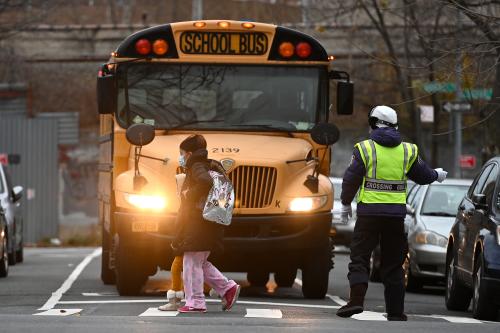In recent decades, the hollowing out of Rust Belt towns, a devastating opioid crisis, and bitterly divisive national politics have called attention to the challenges of growing up in rural America. Despite enhanced focus on these communities, educational opportunity in rural areas is less clearly understood than in nonrural areas, owing in part to the fact that studying rural education nationwide has been an empirical challenge: many rural school districts are small, and most state achievement tests are not comparable across state lines. Nonetheless, rural youth collectively comprise 20 percent of public school students in the United States, and understanding the status of their educational opportunity is important.
New data allow us to address this topic more comprehensively than ever before. As recent advancements have enabled researchers to aggregate local data into massive datasets, scholars are now able to unearth new findings and compare outcomes across places with greater confidence. The Stanford Education Data Archive (SEDA), led by Professor Sean Reardon of Stanford, has compiled over 430 million standardized test scores and placed them on a common scale, allowing researchers to explore previously hard-to-answer questions about educational patterns and disparities across the U.S.
In a study published in RSF: The Russell Sage Foundation Journal of the Social Sciences in May, we examine the rural education landscape in great detail. We explore three primary questions:
- Do student achievement and learning rates vary across different types of rural districts? Specifically, do we see differences by region of the country, relative geographic isolation, and characteristics of the local economy?
- Do any educational differences across rural districts simply reflect differences in demographic factors, such as socioeconomic status and racial/ethnic composition?
- How do patterns of average academic performance and learning rates differ for rural versus nonrural students? Do these patterns vary for different student groups?
To pursue this project, we leverage the SEDA dataset, which provides measures of educational opportunity for nearly all schools and districts in the United States. We focus on two measures: average third-grade achievement and learning rates from third to eighth grade. A community’s achievement score corresponds to local third-grade students’ average standardized test score, while its learning rate indicates achievement changes across grade levels or how much the average student learns each year. For this post, we focus on achievement, which we interpret as a reflection of students’ early childhood educational opportunities; this includes both school experiences and out-of-school resources often tied to a community’s average socioeconomic status.
First, however, we must define what exactly constitutes “rural” education. Of an average nationwide enrollment of 3.75 million students per grade, approximately 715,000 (19 percent) attend “rural” schools; 540,000 (14 percent) attend “rural” districts; and 553,000 (15 percent) are in “rural” counties. Some students appear in multiple categories, and some do not. So which group of students should be considered “rural”?
We choose to focus on the 14 percent of U.S. students enrolled in rural districts. While 18 percent of students in this category are technically enrolled in “nonrural” schools, a district-level analysis may better capture students whose broader educational context is “rural,” as many educational choices are made at the district level (e.g., teacher hiring and resource allocation decisions).
Our analysis of these rural districts produced three key findings.
First, we find substantial differences in achievement across different rural communities. Place matters a lot. For example, rural students in New England are scoring a grade level ahead of the national average, whereas rural students in the Pacific region of the U.S. are performing a grade level below the national average. That is a difference of two grade levels between New England and Pacific rural students. Some, but not all, of this geographic variation is explained by demographic differences. For example, in the South Atlantic region—where rural students are a grade level below New England—the regional difference in achievement disappears when we control for demographics. In the Mid-Atlantic, not so much. This suggests that educational opportunities for rural students are more stratified in some places than others. In some rural districts, poor and nonpoor students are experiencing similar levels of educational opportunity, whereas in other rural districts, poor and nonpoor students see pronounced test score differences.
We also examine whether the remoteness of a rural place is linked to student success. Broadly, we find that districts farthest from urban centers do score lower, on average. This is only partially accounted for by difference in community demographics. In other words, geographic isolation appears to have a negative association with achievement beyond what can be attributed to differences in community socioeconomic status or racial/ethnic composition.
Next, we find very small differences in achievement between rural and nonrural students nationwide, but this masks larger rural/nonrural differences within specific groups of students. At first glance, some parts of Figure 1 present a puzzle. Overall, we see almost no difference in rural and nonrural achievement. However, when we look at each racial/ethnic group individually, we see that nonrural students tend to outscore rural students of the same group, in some cases substantially. For example, rural white students score over half of a grade level lower than nonrural white students (0.18 standard deviations). Differences in achievement for rural and nonrural Native American students are nearly as large (0.15 standard deviations). Hispanic students in rural districts slightly outscore Hispanic students in nonrural districts, but the difference is small.
Why do we see test score differences among student subgroups but not among students overall? This apparent contradiction is the product of differences in population distribution. For example, white students score above average in both rural and nonrural areas, but since they comprise a much higher share of the rural student population than the nonrural population, they raise the overall average for rural districts.
It’s also important to note that “nonrural districts” is a category that encompasses many different types of districts. Though the overall difference between rural districts and nonrural districts is small, the differences between rural districts and urban, suburban, and town districts, separately, are much larger in magnitude.
Finally, district socioeconomic status appears to matter less for achievement in rural areas than nonrural areas. Whereas poorer rural students are nearly a third of a grade level ahead of poorer nonrural students, wealthier rural students are behind wealthier nonrural students by about the same margin. In other words, though socioeconomic status is still the factor most strongly predictive of student achievement, achievement differences at each end of the socioeconomic spectrum appear less extreme for rural students than for nonrural students.
We suspect, though cannot confirm empirically, that both “floor” and “ceiling” effects could be at play. There may be a “ceiling” effect in rural communities, such that resources which traditionally benefit students from wealthier families are less widely available in rural areas. For example, existing literature suggests that rural schools struggle to provide support for gifted student programs, while after-school programming is less prevalent in rural areas. Similarly, there could be a “floor” effect due to rural communities having relatively lower population density, which means that a community might be served by a single school or program. This could result in the communities’ poorest children attending the same childcare centers, classrooms, and extracurricular spaces as the communities’ wealthiest children, which may benefit these poorer children.
In light of these findings, we offer a few recommendations for practitioners and policymakers. First, expand rural broadband access. Greater connectivity can enable districts to expand virtual tutoring and other enrichment opportunities for students, particularly for those in more isolated areas, and help them achieve at higher levels. Further, consider policies that help rural students who wish to attend college overcome the non-academic hurdles they may face. Though rural students on average score at least as well as their nonrural counterparts, they attend and graduate college at lower rates. Since the data we use are drawn from third-grade test scores, it is possible rural students fall behind by high school. However, research suggests rural students face many hurdles to educational attainment outside of achievement, including financial burden, geographic isolation from higher education institutions, and few nearby jobs requiring a college degree.
We also call upon our fellow researchers to continue exploring rural educational opportunity. Further work is needed to understand the mechanisms which allow rural districts to attenuate the connection between socioeconomic status and student achievement. Regions such as New England, in which the average rural student outperforms the national average for all students by a whole grade level, may provide useful case studies. We hope subsequent efforts will uncover insights that can better enable policymakers to support students of all backgrounds.






Commentary
What is the status of educational opportunity in rural America?
Wednesday, July 20, 2022